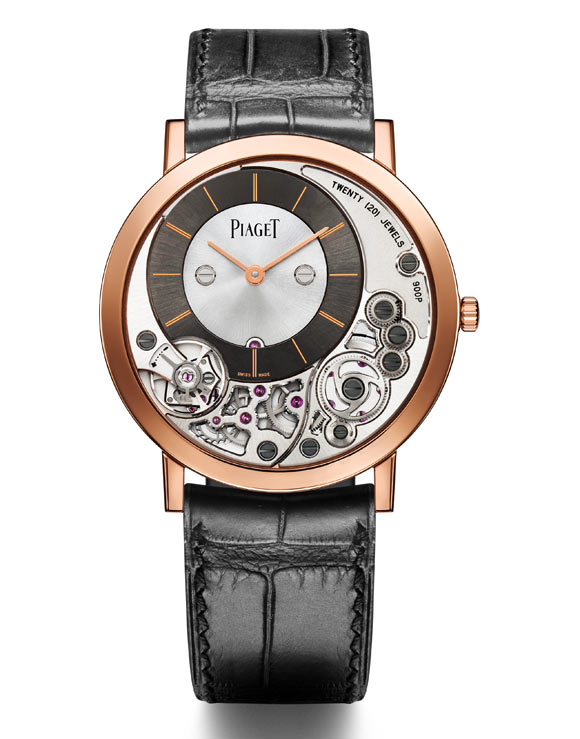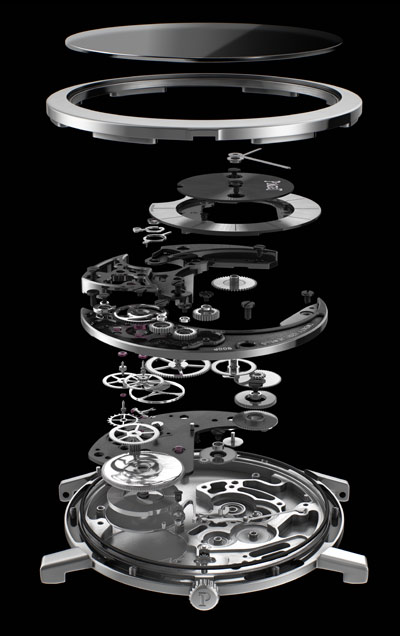While clearly geared towards cutting-edge innovation, the Altiplano 38 mm 900P is also a nod to history, since it gets the 900P part of its name from Calibre 9P, which was the first ultra-thin hand-wound movement made by Piaget in 1957, measuring just 2 mm thin. By 1960, Piaget was ready to set a first record with its Calibre 12P, the world’s thinnest automatic movement at just 2.3 mm. The following years witnessed a spate of new slimness records in the fields of hand-wound and automatic models, with or without horological complications.
Merging the skills of the two integrated Manufactures
Making an ultra-thin watch is a constant challenge. Right from the first project sketches, all those involved must anticipate the functional, aesthetic and durability constraints involved in paring down parts to the extreme. While the Altiplano 38 mm 900P merges the case and movement to establish itself as the thinnest mechanical watch, it also stems from another fusion: that of the two Manufactures Piaget – one based in La Côte aux Fées, where the movements are traditionally made; and the other in Plan-les-Ouates, where the cases are crafted.
For a full three years, watchmakers, case constructors and designers worked together at each stage of development, production, adjustment and finishing in order to give life to this slender marvel. Each technical choice had an aesthetic impact, and vice versa. While each of the 145 parts composing the Altiplano 38 mm 900P has been trimmed to a size sometimes barely thicker than a hair’s breadth – including some wheels measuring a mere 0.12 mm thin (compared with 0.20 mm on a classic movement) – special care has been devoted to clearances. In other words, the process involved cleverly arranging the components to within the nearest hundredth of a millimetre so as to create optimal play between the fixed and mobile organs, while being careful to ensure that the later move freely and thus guarantee the smooth running of the mechanism.

Merging calibre and case
The true secret of this extreme slenderness lies in the structure of the case itself, of which the back also serves as the mainplate. Thereby merging calibre and case, the latter was machined directly from the case-back in order to house the mechanical parts. This highly complex architecture meant reversing movement construction so as to fit the bridges on the dial side – an approach that also has an aesthetic effect by keeping them visible. To save another precious few millimetres, the entire mechanism and the hand-fitting system are contained within the thickness of the balance-wheel itself, thus entailing an off-centred display of the hours and minutes entirely in tune with the iconic design features of the Altiplano line. These characteristics are further enhanced by the entirely visible wheel-train that invites the owner of the watch to plunge into the very heart of this supremely slender and technically sophisticated mechanism. Working within this extremely confined space, Piaget has devised a suspended barrel hanging from a single bridge on the dial side, contrary to classic barrels that are also fixed to the mainplate side. This highly unusual device is no way detrimental to the performance of the mechanism, since the Altiplano 38 mm 900P has a generous power reserve of around 48 hours.

A patent pending for a major breakthrough in promoting reliability
When a watch is subjected to strong pressure, such as when immersed in water, its glass or crystal is slightly deformed. While this physical phenomenon goes relatively unnoticed on a classic timepiece, the same is certainly not true of an ultra-thin watch. Given the extremely confined space available, the glass would be liable to press on the hands when deformed, thus causing the movement to stop. To avoid this challenge to any ultra-thin model, Piaget has come up with a new device (patent pending) representing a major breakthrough in ensuring the reliability of this type of watch. Instead of fitting the hands above the bridges, Piaget has placed them underneath, thereby freeing up space between the cannon-pinion and the crystal. When the latter is deformed by the effects of pressure, it presses not on the hands but instead on the wheel-train bridge, thus avoiding any consequences on the rate of the movement.
Uncompromising finishing
Even though some of the 145 parts of the Altiplano 38 mm 900P remain hidden from sight, all of them have been meticulously finished in keeping with the noblest horological traditions. The mainplate carved out of the watch case-back has been satin-brushed and sandblasted, while the wheels are alternately sunburst or circular satin-brushed. Hollowed so as to reveal the mechanical intricacies at the heart of the Altiplano 38 mm 900P, the bevelled and sunburst satin-brushed bridges are black-coated to create elegant contrasts with the white gold case. In its pink gold version, the watch bears anthracite mechanical elements.
Click on the image on top of the page to view all the Altiplano 900P models.






